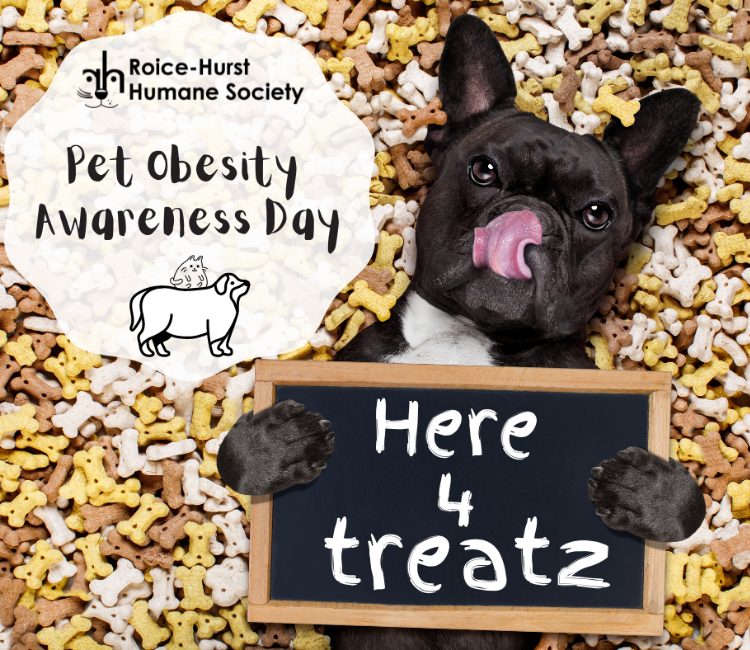When you love your pets as much as they love their favorite foods and treats, it can be difficult knowing when to say no when they are begging for just one more treat. If you love them, you’ll give them all the treats and yummy foods they could ever desire, right? While that seems like a really great deal to your furry food-lover, it can very quickly turn into too much of a good thing. Is it hard to say no to those cute faces and put the treats away for the day? For a lot of pet owners the answer is a strong yes. In the long run, you and your pet will be thankful you said, “That’s enough for today.”
National Pet Obesity Awareness Day (October 13) is dedicated to raising awareness of one of the most common — and often misunderstood — conditions many pets face. Pet obesity is so common, the Association for Pet Obesity Prevention claims it is the #1 threat to a pet’s health, stating “up to 59% of dogs and cats are overweight, making obesity one of the most common medical disorders identified in veterinary practice.” But is pet obesity really a medical disorder, or does it simply mean there’s more of them to love? Pets of all shapes and sizes deserve to be loved, but for pets living with obesity, it could mean you’ll love them for less time than you would’ve if they maintained a healthy weight.
In addition to shortening your pet’s lifespan, obesity significantly decreases their quality of life, even if your pet seems overjoyed to eat another treat. Obesity in pets can increase their chances of developing diabetes, arthritis, and cancers while impairing respiratory, cardiovascular, and renal functions. But that’s not all — it can also lead to many other conditions including skin conditions, chronic inflammation, reduced mobility, high blood pressure, and even organ diseases/failure. It might seem like just a few extra pounds, but in reality, it can open the door to many dangerous health conditions for your beloved pet.
So how do you know if your pet is at a healthy weight? It might seem like a simple question to answer, but a pet’s weight can’t be categorized simply by a number on the scale. Pets come in countless shapes, sizes, and weights — even if they are classified as the same breed. Males usually are larger than females, so a 55lb female labrador could be at a healthy weight, while a 55lb male labrador could be considered significantly underweight.
But what if both pets are the same height? Even if they appear to be of similar height, what might be considered a healthy weight for one pet might be overweight, or even underweight, for another pet. For example, a female rottweiler typically ranges from 22–25 inches tall, and a female greyhound is typically 27-28 inches tall. A greyhound is typically a little taller than a rottweiler, so should it weigh the same or more than the rottweiler? Nope. Even though they are similar in height, both dogs differ significantly when it comes to a healthy weight. The female rottweiler ranges 77–110lbs and the female greyhound ranges 57–75lbs. A 76lb female rottweiler could be considered underweight, while a 76lb female greyhound could be overweight. Likewise, a 100lb rottweiler could be at an optimal weight, but a greyhound of that weight would probably be morbidly obese. Both dog breeds are similar in height, but they are very different when it comes to body composition.
Since your pet’s healthy weight can’t be determined by a number on the scale alone, what’s the best way to determine a healthy weight for your pet? The best way to figure out an ideal weight and body condition for your pet is to talk with your vet. They will be able to assess your pet as an individual and determine a weight range that is appropriate, as well as provide recommendations on how to achieve and maintain those goals. Another great tool to become familiar with as a pet owner is the Body Condition Scoring system. This tool is great to have on hand as it can help you score your pet’s body condition at any time and can help you determine if they fall within an ideal range. Below is an example of the scoring system and what each score represents. Your vet can also teach you how to understand this chart more thoroughly and how it can be used at home to track your pet’s progress.


We are all for rewarding your pet with yummy treats they love, but please remember to do so responsibly. Proper diet and exercise play a huge role in your pet’s health, and while it might be hard to put a limit on food and treats, your pet will be thankful you did. Unlike people, pets aren’t able to make dietary choices or create a diet plan that helps achieve or maintain a healthy weight. As pet owners, we are responsible for making those dietary choices for them. Healthy choices we can start making for our pets can include measuring the correct amount of food being fed, limiting treats, increasing daily exercise, and even using praise, play, and attention as a reward for good behavior rather than endless treats. Your pet may love food, but they also really love you as well!
If you’d like to learn more about achieving or maintaining an optimal weight for your pet, check out the AVMA’s Your Pet’s Healthy Weight guide as well as the Association for Pet Obesity Prevention’s pet weight tools. Be sure to talk with your veterinarian before starting any diet modification programs to ensure it is a good fit for your pet’s needs. A healthy pet is a happy pet!

